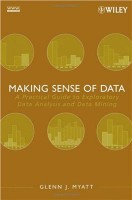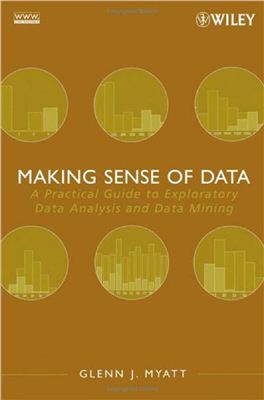 Author: Glenn J. Myatt
Author: Glenn J. Myatt
Publisher: Wiley-Interscience
Book Review by: Nano Khilnani
The process of taking raw data and converting it into meaningful information necessary to make decisions is the focus of this book.
In many fields – such as biology, economics, engineering and marketing, to name a few important ones – organizations measure, gather and store data for specific purposes in electronic databases. They then tabulate and analyze that data to find distinct patterns which help them to solve problems or achieve their objectives.
Each organization has a different objective. The data help a particular entity paint a picture of the respondents and responses.
For example a chain store may want to find out how many pairs each of a newly-introduced brand-name shoe style sold in the first month or the first 30 days in each of its, say, 100 stores. After gathering the data from sales registers, they may find for example, that 10 of those stores sold not a single pair, 20 stores sold one to 5 pair each, 30 other stores sold anywhere from 6 to 12 pair each and the balance 40 stores sold anywhere from 13 pair to 20 pair each.
Arraying these unit sales of shoes on a chart, they may find some distinct sales patterns. For example, they may discover that fewer quantities of that particular brand or shoe style sold in urban versus suburban stores; and fewer quantities in lower versus higher income towns, and so on.
There is so much data being generated automatically these days, that there is information overload. Sometimes the data gathered is not even tabulated and analyzed to find patterns and meaning that make the data useful and usable. When patterns and meaning are found in the data, management can make certain decisions to accomplish the very purpose of gathering the data in the first place.
Otherwise, what is the purpose of gathering data, if it is not used to make decisions? The purpose of the organization could be to lower cost, or to increase revenue, or to increase profit margins. Whatever may be the purpose, it must be set forth in beginning of the process of data gathering.
Glenn Myatt states in his Preface that the purpose of this book is to “describe a practical approach for making sense of data.” Many organizations go about formulating their data-gathering plan and then implement it but they run into “some of the common pitfalls associated with complex data analysis or data mining projects,” he points out.
He explains this a little further: “The process starts by understanding what business problems you are trying to solve, what data will be used (after it is obtained) and how, who will use the information generated and how will it be delivered to them. A plan should be developed that includes this problem definition and outlines how the project is to be implemented. Specific and measurable success criteria should be defined and the project evaluated against them.”
Typically, a lot of data is gathered at the end of the survey process, which has many parts to it. Oftentimes, the people who receive this immense and varied data are overwhelmed by it, and do not know what to with this huge amount of information.
Glenn Myatt writes that in this book are provided some of the common tasks relating to the analysis of data, including:
- How to summarize and interpret the data
- How to identify nontrivial facts, patterns and relationships in the data, and
- How to make predictions from the data
In addition to the above tasks relating to the analysis of data, this book covers other aspects of the work of making sense of data, including but no limited to:
- Problem definitions
- Data preparation
- Data visualization
- Statistics
- Grouping methods
- Predictive modeling
- Deployment issues
- Applications
This book is written in plain language and is useful to you who wants to learn about the business of gathering and analyzing data and accomplishing the objectives you set beforehand. Its most important message I think is that you define the problem so that the data gathered will be tailored to solving it.







